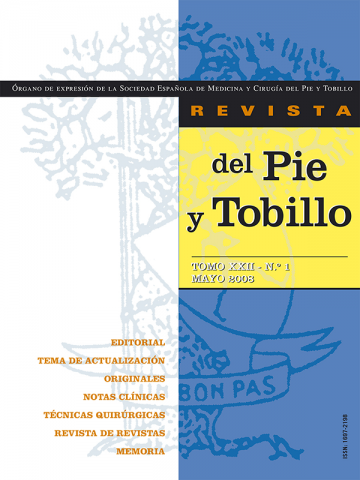Resumen:
Introducción el objetivo de este trabajo es analizar las distintas técnicas quirúrgicas que ofrece el tratamiento artroscópico en las lesiones osteocondrales de astrágalo. También revisamos la evolución artroscópica del tratamiento de dichas lesiones en el Hospital Universitario 12 de Octubre.
Material y método: entre los años 2000 y 2006 fueron intervenidos quirúrgicamente 28 pacientes con 29 lesiones osteocondrales de astrágalo sintomáticas en el Hospital 12 de Octubre (17 hombres; 11 mujeres). La edad media de la serie fue de 42,6 años (23-62). De acuerdo con la clasificación por RMN de Ferkel se dividieron en 5 de tipo I, 5 de tipo IIA, 7 de tipo IIB, 7 de tipo III, y 5 de tipo IV. Todos los pacientes fueron intervenidos mediante técnicas artroscópicas. Se realizaron sinovectomías y desbridamiento de la lesión en 13 pacientes, perforaciones con agujas de Kirschner en 9, y en 7 casos se procedió a la reparación de la lesión osteocondral, 4 de ellos con la técnica de la mosaicoplastia y 3 con un sustituto osteocondral sintético (TruFit® CB Plugs, OBI).
Resultados: en la valoración final se utilizó la escala de tobillo de la AOFAS sobre un total de 100 puntos. La puntuación media de la serie fue de 72,4 puntos. Analizamos la valoración en función del tipo de técnica artroscópica empleada. La complicación más frecuente observada fue el dolor persistente de tobillo, fundamentalmente en aquellos casos tratados con sinovectomía o desbridamiento.
Conclusiones: en lesiones osteocondrales de astrágalo en estadios III-IV y de alrededor de 1 cm2 de tamaño recomendamos las técnicas de sustitución/reparación de la lesión mediante injertos osteocondrales autólogos o sintéticos. Los sustitutos sintéticos OBI constituyen una alternativa ideal para rellenar defectos de de composición exacta evitando la morbilidad de las zonas donantes.
Abstract:
Background and aims the aim of the present work is to examine the various surgical techniques for arthroscopic management of osteochondral lesions of the talus. We also examine the arthroscopic evolution of the management of these lesions at the “12 de Octubre” University Hospital in Madrid (Spain).
Material and methods: between the years 2000 and 2006, 28 patients (17 males; 11 females) with 29 symptomatic osteochondral lesions of the talus underwent surgical therapy at the “12 de Octubre” University Hospital. The average age of the patients was 42.6 years (23-62). According to Ferkel’s MR classification, there were 5 type I, 5 type II A, 7 type II B, 7 type III, and 5 type IV cases. All the cases were treated using arthroscopic techniques. Synovectomy and debridement was performed in 13 patients, perforation with Kirschner wires in 9, and repair of the osteochondral lesion in 7 (4 with the mosaicplasty technique and 3 with a synthetic osteochondral substitute [TruFit® CB Plugs, OBI]).
Results: the AOFAS ankle scoring scale (0 to 100 score points) was used for the final assessment. The mean score for the series was 72.4. We have analyzed the assessment considering the type of arthroscopic technique used. The most frequently observed complication was persistent ankle pain, mostly in those cases treated with synovectomy and/or debridement.
Conclusions: in osteochondral lesions of the talus in stages III-IV and about 1 cm2 in size, we recommend the use of lesional substitution / repair with autologous or synthetic osteochondral grafts. The OBI synthetic substitutes represent an ideal alternative for filling exact composition defects, avoiding morbidity of donor areas.





